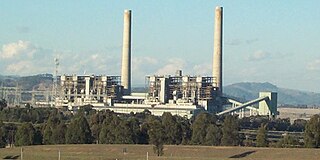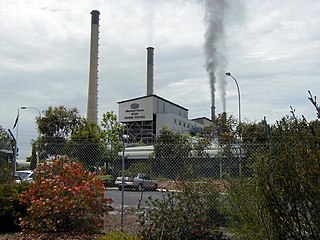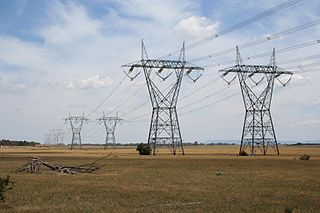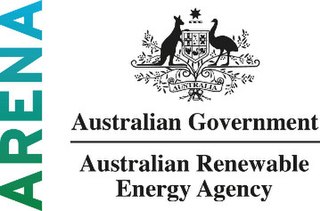These fossil fuel power stations burn coal to power steam turbines that generate some or all of the electricity they produce. Australia's fleet of coal-fired power stations are aging and many are due for decommissioning, and are being replaced by a combination of mostly renewable energy. In early 2017, 75% of the coal-fired power stations in the country were operating beyond their original design life. [1]
The declining cost of renewable energy sources, such as solar power, wind power and battery storage, means it is unlikely a new coal-fired power station will ever be built in Australia. [2] The Liddell Power Station is the latest major coal-fired power station to be decommissioned, which took place on 28 April 2023. [3]
| Power station | Commission year | Scheduled closure year | Max. capacity (MW) | CO2 emissions (t CO2-e/year) | Emission intensity (t CO2-e/MWh) | Turbines | Coal type | Conveyance | Mine type | Cooling water | Status | Owner |
|---|---|---|---|---|---|---|---|---|---|---|---|---|
| Bayswater | 1982 [4] | 2033 [5] | 2,640 | 13,725,965 [6] | 0.88 [6] | 4 | bituminous | conveyors, rail | open cut | fresh | Active | AGL |
| Eraring | 1982 [4] | 2025 [7] [lower-alpha 1] | 2,880 | 14,914,916 [6] | 0.87 [6] | 4 | bituminous | rail, truck | underground | salt | Active | Origin |
| Mt Piper | 1993 [4] | 2040 [9] [10] | 1,400 | 6,841,302 [6] | 0.87 [6] | 2 | bituminous | road, conveyor | underground | fresh | Active | EnergyAustralia |
| Vales Point B | 1978 [4] | 2029 [11] | 1,320 | 7,015,626 [6] | 0.86 [6] | 2 | bituminous | conveyors | underground | salt | Active | Delta |
Total (MW): 8,240
| Power station | Commission year | Scheduled closure year | Max. capacity (MW) | CO2 emissions (t CO2-e/year) | Emission intensity (t CO2-e/MWh) | Turbines | Coal type | Conveyance | Mine type | Cooling water | Status | Refs | Owner |
|---|---|---|---|---|---|---|---|---|---|---|---|---|---|
| Callide B | 1989 [4] | 2028 [12] | 700 | 5,103,540 [6] | 0.92 [6] | 2 | bituminous | conveyor | open cut | fresh | Active | [13] [14] | CS Energy, Intergen |
| Callide C | 2001 [4] | Not Announced [15] | 810 | 5,265,665 [6] | 0.9 [6] | 2 | bituminous | conveyor | open cut | fresh | Active | [13] [14] | CS Energy, Intergen |
| Gladstone | 1976 [4] | 2035 [12] | 1,680 | 8,547,021 [6] | 0.95 [6] | 6 | bituminous | rail | open cut | seawater | Active | [13] | Rio Tinto, NRG |
| Kogan Creek | 2007 [4] | 2042 [15] | 750 | 4,360,686 [6] | 0.83 [6] | 1 | bituminous | conveyor | open cut | dry cooled | Active | [13] | CS Energy |
| Millmerran | 2002 [4] | 2051 [15] | 852 | 5,794,351 [6] | 0.82 [6] | 2 | bituminous | conveyor | open cut | dry cooled | Active | [13] | Intergen [16] |
| Stanwell | 1993 [4] | 2046 [15] | 1,445 | 7,637,735 [6] | 0.87 [6] | 4 | bituminous | rail | open cut | fresh | Active | [13] | Stanwell |
| Tarong | 1984 [4] | 2037 [15] | 1,400 | 10,473,950 [6] | 0.86 [6] | 4 | bituminous | conveyor | open cut | fresh | Active | [13] [17] | Stanwell |
| Tarong North | 2002 [4] | 2037 [15] | 443 | 1 | bituminous | conveyor | open cut | fresh | Active | [13] | Stanwell |
Total (MW): 8,080
| Power station | Commission year | Scheduled closure year | Max. capacity (MW) | CO2 emissions (t CO2-e/year) | Emission intensity (t CO2-e/MWh) | Turbines | Coal type | Conveyance | Mine type | Cooling water | Status | Owner |
|---|---|---|---|---|---|---|---|---|---|---|---|---|
| Loy Yang A | 1984 [4] | 2035 [18] | 2200 | 20,107,115 [6] | 1.17 [6] | 4 | lignite | conveyors | open cut | fresh cooling tower | Active | AGL |
| Loy Yang B | 1993 [4] | 2047 [15] | 1050 | 10,132,776 [6] | 1.14 [6] | 2 | lignite | conveyors | open cut | fresh cooling tower | Active | Chow Tai Fook, Alinta Energy [19] |
| Yallourn Power Station | 1975 [4] | 2028 [20] [21] | 1480 | 13,856,313 [6] | 1.34 [6] | 4 | lignite | conveyors | open cut | fresh cooling tower | Active | EnergyAustralia |
Total (MW): 4,730
| Power station | Commission year | Scheduled closure year | Max. capacity (MW) | CO2 emissions (t CO2-e/year) | Emission intensity (t CO2-e/MWh) | Turbines | Coal type | Conveyance | Mine type | Cooling water | Status | Owner |
|---|---|---|---|---|---|---|---|---|---|---|---|---|
| Collie | 1999 [4] | 2027 [22] | 340 | 1,848,693 [6] | 0.91 [6] | 1 | bituminous | conveyor | open cut | fresh | Active | Synergy |
| Muja | 1981 [4] | 2024 (Unit 6) [23] 2029 (Units 7 & 8) [22] | 654 | 3,982,663 [6] | 0.9 [6] | 4 | bituminous | conveyor | open cut | fresh | Active (units 1–5 closed) | Synergy |
| Bluewaters | 2009 [4] | – | 416 | 2,966,541 [6] | 0.88 [6] | 2 | bituminous | conveyor | open cut | fresh | Active | Sumitomo Group, Kansai Electric |
Total (MW): 1,410
The Australian Capital Territory does not use coal or oil to generate electricity. The Kingston Powerhouse being the last coal-fired power station in the territory, which was decommissioned in 1957.
The Northern Territory relies predominantly on natural gas, as well as various renewable energy sources. Likewise, it has no functioning coal-fired power stations.
South Australia previously had a number of coal power stations. The last to be closed were the Northern and Playford B power stations. [25]
Tasmania has no functioning coal-fired power stations, instead using primarily hydroelectricity, with natural gas used as a backup.

India is the third largest producer of electricity in the world. During the fiscal year (FY) 2022–23, the total electricity generation in the country was 1,844 TWh, of which 1,618 TWh was generated by utilities.

The Loy Yang Power Station is a brown coal- fired thermal power station located on the outskirts of the city of Traralgon, in south-eastern Victoria, Australia. It consists of two sections, known as Loy Yang A and Loy Yang B. Both Loy Yang A and B are supplied by the Loy Yang brown coal mine. The Loy Yang power stations are located in the brown coal rich Latrobe Valley, along with the Yallourn Power Station.

The State Electricity Commission of Victoria is a government-owned renewable electricity investment enterprise in Victoria, Australia. Originally a major energy supplier in the state, the SEC was privatised in the 1990s before being revived in 2023 to invest in renewable energy and storage.

Eraring Power Station is a coal-fired power station consisting of four 720 MW Toshiba steam-driven turbo-alternators for a combined capacity of 2,880 MW. The station is located near the township of Dora Creek, on the western shore of Lake Macquarie, New South Wales, Australia and is owned and operated by Origin Energy. It is Australia's largest power station. The plant has two smokestacks rising 200 m (656 ft) in height. It is slated for closure by mid-2025, after a failed attempt to sell the loss making power station back to the state government.

Liddell Power Station is a decommissioned coal-fired thermal power station that had four 500 megawatts (670,000 hp) EE steam-driven turbine alternators, providing a combined electrical capacity of 2,000 megawatts (2,700,000 hp).

Torrens Island Power Station is located on Torrens Island, near Adelaide, South Australia and is operated by AGL Energy. It burns natural gas in eight steam turbines to generate up to 1,280 MW of electricity. The gas is supplied via the SEAGas pipeline from Victoria, and the Moomba Adelaide Pipeline System (MAPS) from Moomba in the Cooper Basin. The station is capable of burning either natural gas or fuel oil. It is the largest power station in South Australia and was formerly the largest single power station user of natural gas in Australia.

Muja Power Station is a power station 22 km (14 mi) east of Collie, Western Australia. It has eight steam turbines served by coal-fired boilers that together generate a total capacity of 854 megawatts of electricity. It is the largest power station in the South West Interconnected System, accounting for roughly 15 percent of capacity. The coal is mined in the nearby Collie Sub-basin. On 14 June 2022 the state government announced that Synergy would close Muja Power Station by 2029.
Collie Power Station is a power station in Collie, Western Australia. It is coal powered with one steam turbine that generates a total capacity of 300 megawatts of electricity. The coal is mined locally from the Collie Sub-basin and is transported to the power plant by overland conveyor. On 14 June 2022 the state government announced that Synergy would close Collie Power Station by 2027.

AGL Energy Ltd is an Australian listed public company involved in both the generation and retailing of electricity and gas for residential and commercial use. AGL is Australia's largest electricity generator, and the nation's largest carbon emitter. In 2022, 83% of its energy came from burning coal. It produces more emissions as a single company than the nations of New Zealand, Portugal or Sweden, according to its largest shareholder, Mike Cannon-Brookes, who named it "one of the most toxic companies on the planet".

Energy in Victoria, Australia is generated using a number of fuels or technologies, including coal, natural gas and renewable energy sources. Brown coal, historically, was the main primary energy source for the generation of electricity in the state, accounting for about 85% of electricity generation in 2008. The amount of coal-fired power has decreased significantly with the closure in 2017 of the Hazelwood power station which supplied around 20% of Victoria's electricity, and to a lesser extent with the exit of Anglesea power station in 2015. Brown coal is one of the largest contributors to Australia's total domestic greenhouse gas emissions and a source of controversy for the country. Australia is one of the highest polluters of greenhouse gas per capita in the world.

Coal phase-out is an environmental policy intended to stop using the combustion of coal in coal-burning power plants, and is part of fossil fuel phase-out. Coal is the most carbon-intensive fossil fuel, therefore phasing it out is critical to limiting climate change and keeping global warming to 1.5 °C as laid out in the Paris Climate Agreement. The International Energy Agency (IEA) estimates that coal is responsible for over 30% of the global average temperature increase above pre-industrial levels.

Energy in Sweden describes energy and electricity production, consumption and import in Sweden. Electricity sector in Sweden is the main article of electricity in Sweden. The Swedish climate bill of February 2017 aims to make Sweden carbon neutral by 2045. The Swedish target is to decline emission of climate gases 63% from 1990 to 2030 and international transportation excluding foreign flights 70%. By 2014 just over half of the country's total final energy consumption in electricity, heating and cooling and transport combined was provided by renewables, the highest share amongst the then 28 EU member countries. About a third of Sweden's electricity is generated by nuclear power. In generating a year's worth of this energy, Swedes generate about 4 tonnes of CO2 emissions each. Since 2010, sustainability measures have reduced total emissions even as the population has increased.
South Australia is a leader in utility-scale renewable energy generation, and also produces gas and uranium for electricity generation. Gas production is mostly concentrated in the Cooper Basin in the state's north-east. Gas is delivered from these fields by pipeline to users interstate and to Port Adelaide where it fuels three separate gas-fired power plants. Uranium is also mined in South Australia, though nuclear power generation is prohibited nationally. The Olympic Dam mine is the world's single largest known deposit of uranium and represents 30% of the world's total uranium resource. Many utility-scale wind farms and solar farms have been commissioned during the 21st century and geology with potential for geothermal energy has also been identified but is yet to be developed.

The Australian Renewable Energy Agency (ARENA) is an independent agency of the Australian federal government, established in 2012 to manage Australia's renewable energy programs, with the objective of increasing supply and competitiveness of Australian renewable energy sources.
{{cite web}}: CS1 maint: multiple names: authors list (link)